Intel's Latest Hardware Is A Cut Above
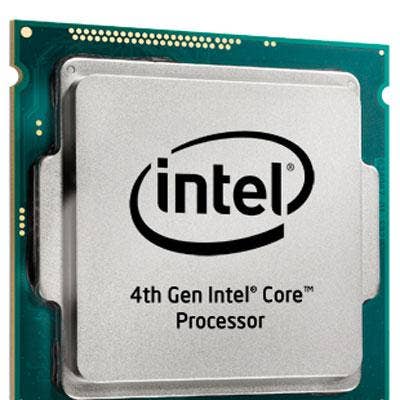
The 3 Ps: Power, Price, Performance
The results are in, and Intel's latest series of solid-state hard drives and 4th-generation Core i7 processors have topped the charts in all major categories. Based on performance tests conducted this week by the CRN Test Center, Intel's Data Center S3500 Series solid-state drives are the fastest SSDs we've ever tested. Unveiled on June 11 were eight 2.5-inch models and four 1.8-inch models, ranging in capacity from 80 GB to 800 GB, and starting at $115.
Also impressive is the Intel Core i7-4770K processor, one of four new CPUs code-named Haswell, officially unveiled by the company last week. Despite mixed reviews elsewhere, Intel's quad-core chip outperformed anything comparable that has come through our labs before.
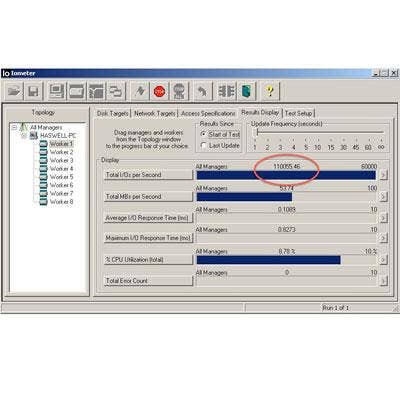
Data Center SSDs
Intel's latest Data Center S3500 Series solid-state drives are built around 20nm NAND technology. They're rated to consume just 1.6 watts while operational, and ramp down to 0.65 watts in standby mode. According to Intel, the drives are designed for virtualized and other transaction-heavy environments. The S3500 series drives are rated to deliver a sustained 75K IOPS (input-outputs per second) for random 4K read operations and 11.5K for random 4K writes.
Our transaction testing involved 512-byte random and sequential read operations, under which the drives actually performed much better. The IOmeter screenshot here shows IOPS for sequential read operations in excess of 110K. That performance rate was reached after a ramp-up of about 30 seconds and sustained indefinitely thereafter. For throughput, we found a maximum sustained data rate of 515 MBps when performing sequential reads of 32K packets. The drive is rated at 500 MBps for read operations. Our standard methodology determined an optimal transaction queue setting of 12, which was used for all IOmeter tests.
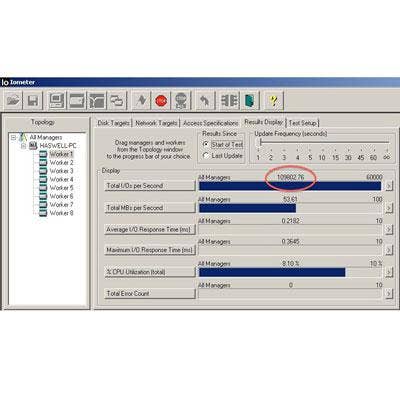
Random Reads
In tests of random read rates, Intel's new SSDs performed almost as well as in sequential tests. This bears out one of the advantages enjoyed by solid-state drives over their spinning magnetic-media counterparts. In tests of 512-byte packets, the S3500 delivered 109K IOPS after a 30-second ramp-up, and sustained the rate indefinitely. All tests were performed on an Intel Desktop Board DZ87KLT-75K motherboard with an Intel Core i7-4770K quad-core Haswell processor, 4 GB of Corsair Dominator 2000MHz DDR3 memory, and IOmeter 2006 running on 64-bit Windows 7 Ultimate.
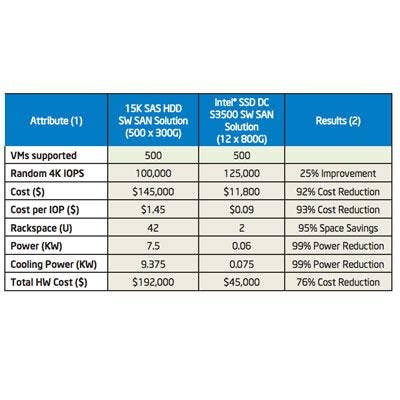
SSD Case Study
The efficacy of Intel SSD drives for transactional environments over traditional spinning media was demonstrated in one of many Intel case studies that the company shared with the CRN Test Center in a recent media briefing. The study sought to reduce the number of drives required to eliminate the random I/O workload and bottleneck often experienced when a large number of VMs share a single storage area network. The I/O traffic of a SAN that serviced 500 client VMs was found to have a read/write ratio of about 90 reads to every 10 writes and required a random processing capacity of 100K 4K IOPS.
To service a workload of this size, a traditional storage system as defined by Intel consisted of 500 15K SAS drives (one 300-GB drive for each VM), required 42U of rack space and cost $145K. Intel claims that just 12 of its 800-GB S3500 Series drives service the same workload for a fraction of the cost and power consumption (see chart).
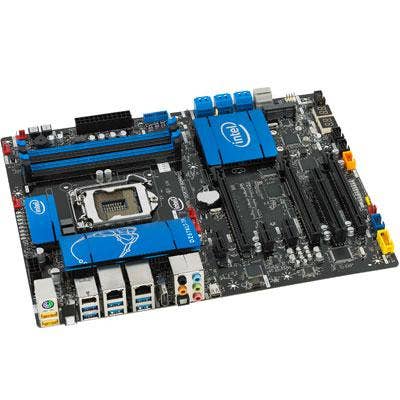
Mother Of A Board
To test the Intel Core i7-4770K processor, Intel sent the Test Center an Intel Desktop Board DZ87KLT-75K motherboard with its quad-core Haswell processor preinstalled in its new LGA 1150 slot. This board contains Intel's Z87 Express chipset, eight internal 6-Gbps SATA ports (plus one external), eight USB 3.0 and eight USB 2.0 ports, three PCIe 3.0 x16 slots, two Gigabit Ethernet ports, two FireWire ports and RAID 0, 1, 5 and 10 capability. Built with enthusiasts in mind, the ATX-sized board has a "back-to-BIOS" button, POST-code LEDs and other overclocking tweakers. Testers added 4 GB of Corsair Dominator 2000MHz DDR3 memory and installed 64-bit Windows 7 Ultimate and the latest version of Geekbench from Primate Labs onto a Corsair 128-GB SSD drive. Results were impressive.
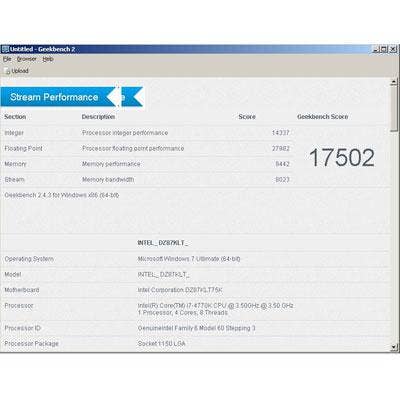
Haswell That Ends Well
Haswell's Geekbench performance results from our tests were off the charts. Before tweaking any performance settings, Geekbench 2.4 reported 16,862, already faster than any laptop or ordinary desktop we've seen. The system really started cooking once we had optimized Windows for performance and downloaded and installed all of Intel's drivers. It delivered a top Geekbench score of 17,502. That score knocked Dell's Precision T1650 Workstation into third place, and took first place from Dell's Precision M6600 Mobile 'Workhorse'.
By July, Intel will be shipping four Haswell SKUs at prices from around $197 for the low-end Core i5 4430 to a high of $368 for the Core i7 4470K tested here. The high-end H-series will include four processor cores and Iris Pro 5200 graphics, Intel's most powerful. The more modestly priced M series will be available with two or four cores. The U series is designed for Ultrabook devices and will be offered at 28 watts with Iros Pro 5200 graphics or 15 watts with Iris (non-pro) 5100.